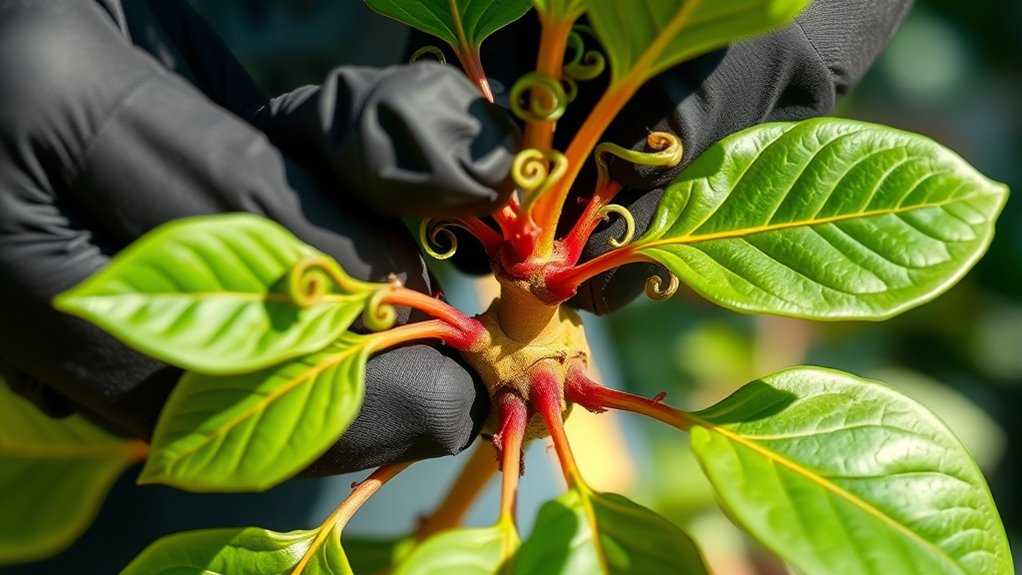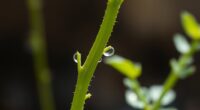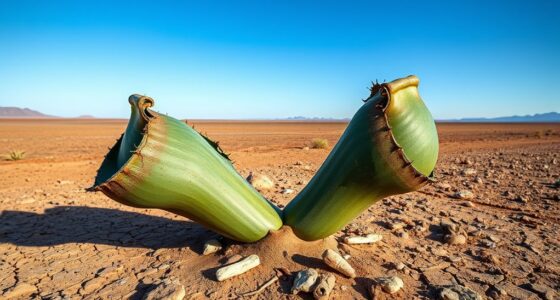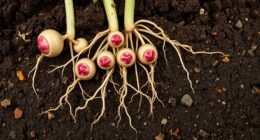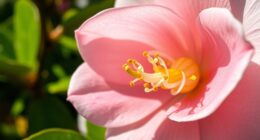To graft rare plants successfully, choose compatible rootstocks and healthy scions to match their vascular and growth traits. Make precise cuts, secure the union with grafting tape, and keep the site clean to promote healing. This technique helps save valuable genetic material, create hybrids, and improve plant resilience. Proper grafting not only preserves rare species but also expands your collection. Keep exploring to discover detailed methods for mastering these essential techniques.
Key Takeaways
- Select healthy, compatible scions and rootstocks to ensure successful grafting and hybrid development.
- Use precise, clean cuts and secure the graft with tape to promote seamless tissue union.
- Preserve desirable traits by carefully collecting and storing scions for future grafting or hybridization.
- Employ disease-resistant rootstocks and sterile tools to prevent infections during grafting procedures.
- Monitor grafts regularly, allowing time for proper healing and verifying the formation of strong, stable unions.
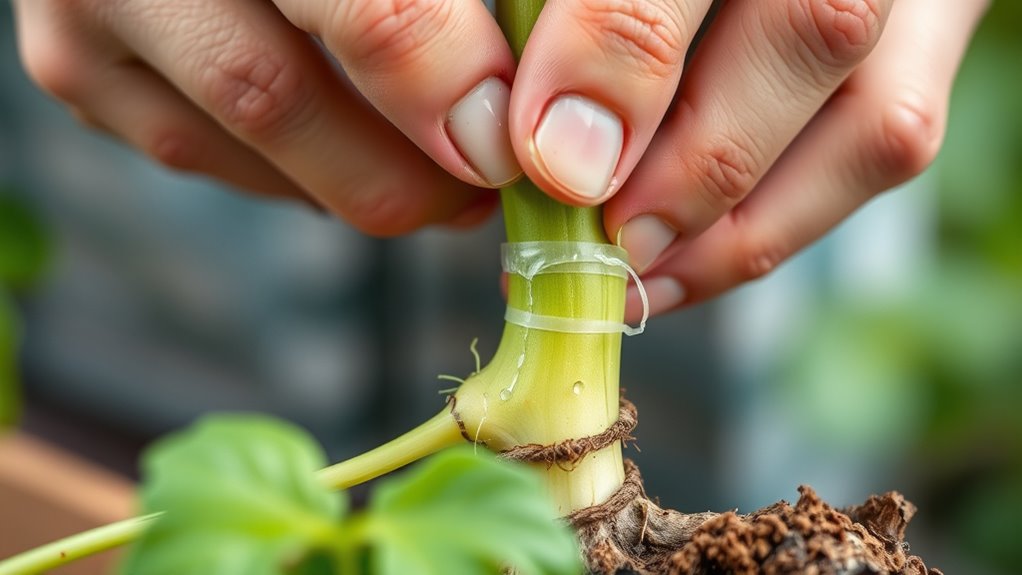
Grafting is an indispensable technique for propagating rare plants, allowing enthusiasts and horticulturists to preserve and expand their collections effectively. When you graft, you’re essentially joining a scion— a piece of a desired plant— to a rootstock, creating a new plant that combines the best traits of both. This method is especially valuable for rare plants, where seed propagation might be unreliable or slow. One of the key benefits of grafting is disease prevention; by selecting healthy rootstocks, you reduce the risk of transmitting soil-borne diseases and pests that could threaten your rare specimens. Proper grafting techniques also enhance graft compatibility, which guarantees the scion and rootstock fuse seamlessly, leading to vigorous growth and long-term stability.
Grafting helps preserve rare plants by ensuring healthy, compatible unions and preventing soil-borne diseases.
To succeed, you must pay close attention to graft compatibility. Not all plants are suitable partners, even if they appear similar. Compatibility depends on factors like genetic relatedness and tissue matching. When choosing your rootstock and scion, make sure they share similar vascular structures and growth habits. This alignment promotes successful graft union and minimizes rejection. If the tissues aren’t compatible, the graft may fail, or the plant could become weak and susceptible to disease. Hence, understanding the specific compatibility requirements of your rare plant species is vital before attempting a graft.
Disease prevention is another critical aspect of successful grafting. By carefully sterilizing your tools and using clean, healthy plant material, you minimize the risk of introducing pathogens. Grafting also allows you to select disease-resistant rootstocks, providing your rare plants with added protection against common pests and illnesses. Additionally, grafting reduces the plant’s vulnerability to soil-borne diseases that often attack the roots, since you can choose rootstocks with inherent resistance. This proactive approach helps guarantee the longevity of your prized specimens.
In practice, you should prepare your grafting site meticulously, making clean, precise cuts to encourage good contact between the scion and rootstock. Secure the union with grafting tape or rubber bands, ensuring there’s no air or moisture gaps that could hinder healing. After grafting, monitor the site regularly, watching for signs of successful union, such as new growth or cambial contact, and for any symptoms of incompatibility or disease. With patience and attention to detail, your grafts can flourish, preserving rare plant genetics and creating beautiful, resilient hybrids that might otherwise be impossible to grow through traditional methods.
Frequently Asked Questions
What Are the Most Common Mistakes in Grafting Rare Plants?
When grafting rare plants, you might encounter common mistakes like improper scion selection, which leads to grafting failure. Make certain you choose healthy, compatible scions and match the cambium layers precisely. Avoid rushing the process or using poorly prepared cuts, as these can also cause failure. Take your time, maintain clean tools, and be patient. These careful steps help increase your success rate and protect your rare plants from unnecessary setbacks.
How Long Does It Take for Grafted Rare Plants to Mature?
Graft maturation time varies depending on the rare plant species and grafting method. Typically, you can expect noticeable growth within a few months, but full maturity may take one to three years. During this period, you should monitor your grafted plant’s rare plant growth carefully, ensuring proper care and conditions. Patience is key, as consistent attention helps your grafted plant reach its full potential and achieve healthy maturity.
Can Grafting Improve Disease Resistance in Rare Plants?
Grafting can definitely enhance disease resistance in rare plants by combining healthy rootstocks with resilient scions. This technique boosts genetic diversity, helping plants better withstand pathogens. By selecting rootstocks with specific disease-resistant traits, you improve your plant’s overall health. Grafting also allows you to create hybrids that carry desirable resistance genes, making your rare plants stronger and more resilient in challenging environments.
What Tools Are Essential for Successful Grafting of Rare Species?
Did you know that using the right grafting tools can boost success rates by up to 90% in rare plant propagation? For successful grafting of rare species, you need sharp knives or grafting blades, budding knives, and grafting tape or wax. These tools guarantee clean cuts and proper sealing, which are essential for healthy scion and rootstock integration. Invest in quality grafting tools to maximize your chances of thriving rare plant hybrids.
Are There Specific Environmental Conditions Needed for Rare Plant Grafting?
You need to take into account climate requirements and soil preferences for successful grafting. Ensure the environment matches the plant’s natural conditions—maintain appropriate humidity, temperature, and light levels. Use well-draining soil suited to the species, as poor soil can hinder graft success. Controlling these conditions helps the grafted plant establish quickly, increasing your chances of survival and growth. Adjust your environment accordingly to optimize your rare plant’s grafting success.
Conclusion
Think of grafting as weaving a delicate tapestry, where each strand must align perfectly to create something new and resilient. Your hands become the weaver’s, blending tradition with innovation, giving rare plants a second chance to flourish. Every cut and join is a step in this dance of life—building bridges between nature’s fragile pieces. With patience and care, you’re not just saving plants; you’re crafting living legacies that will grow and thrive beyond you.

